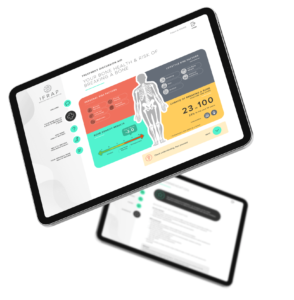Communicating about osteoporosis
Sharing knowledge about osteoporosis
So far, we have learnt about enhanced consultation skills. Now, we will focus more specifically on some of the language and words we might use when talking about osteoporosis and osteoporosis medicines.
Explaining what osteoporosis is
This may involve giving a diagnosis for the first time. Remember to build on what the patient already knows. Also, be aware that receiving a new diagnosis can be overwhelming, meaning that some people stop listening to what is being explained. Consider explaining the problem first e.g.
“As we age, our bones become weaker. We can’t feel the weakness and it does not cause symptoms but it does mean bones may be more likely to break after a simple trip or fall. We call this osteoporosis.”
It is best to describe osteoporosis as a ‘condition’ rather than a ‘disease’, because ‘conditions’ are more likely to be associated with positive management.

Question
We reviewed a number or words or phrases that were used to describe osteoporosis and osteopenia with clinicians and patients.
Giving a diagnosis vs explaining high fracture risk
Sometimes osteoporosis medicine is recommended to people who do not meet the World Health Organisation definition for osteoporosis.
Having a diagnosis helps people make sense of their condition. There is some evidence to suggest people who have a DXA scan might be more likely to adhere to osteoporosis medicine than people who do not have a scan.
- Explain that bone density results are only part of a picture of their bone strength, and that they are at increased risk of breaking bones because of other risk factors.
- If you do not have DXA evidence of osteoporosis, because the patient has not had a scan or because the readings do not fall into the range, consider giving a clinical diagnosis of osteoporosis. You might say “Because of your hip fracture we can assume that you have the condition osteoporosis. This means..”
When talking about fracture risk
Don't say
Just 'high' or 'very high' risk, as people interpret risk in words very differently. People may interpret 'high' or 'very high' risk, to a risk that approaches 100%. This can result in fear, have a negative impact on mental health, social participation, physical activity and wellbeing
Do use labels
Which meaningfully reflect patient management e.g. lifestyle advice (green), investigation (amber), treatment (red) or refer (dark red) e.g. 'your risk falls into the red treatment zone'
Don't use percentages
As they are hard to understand
Do use simple frequencies
With positive and negative framing e.g. for a 23% ten year risk, say, 'for 100 people like you, over the next 10 years, 23 will break a bone and 77 will not'.
The causes of osteoporosis
It is important to explain causes or risk factors that are relevant. Sometimes people feel osteoporosis is their fault for their lifestyle choices. Or, patients may not understand why they have got the condition if there are no obvious causes. It may be appropriate to provide reassurance or explain that it is not unusual to not find a specific cause or reason.
The consequences of osteoporosis (why it is important)
Explain about the physical, social and psychological consequences of broken bones. Spinal fractures deserve specific mention because people often do not realise how these occur, or connect spinal fractures with spine curvature
“spinal fractures happen when the bone squashes down and may cause pain and curving of the spine”
In the introduction, we said that people are more likely to engage with recommended treatment plans if they believe the proposed treatment is important and relevant to their life. What do you already know about how the patient’s previous fractures have affected their life?
Rather than resorting to standard scripts, try and make the explanation personal. For example
“Broken bones from osteoporosis can interfere with day to day life and make getting around, or activities more difficult or impossible.
You told me before about how your wrist fracture stopped you playing the piano. Obviously that is very important to you.”
How bone health can be improved
Being positive
If people think osteoporosis is a condition associated with ageing, they may believe it cannot be treated. They may not realise that treatment can improve bone strength, so it is important to explain that the condition can be improved. This can also be a very positive statement. Explain finding osteoporosis is a good thing because we can do something about it. Keeping up a healthy lifestyle (not smoking, regular exercise) is important in maintaining bone strength and health and osteoporosis medication, if taken regularly will strengthen bone and lower the chance of breaking bones in the future.
Note: In the context of the iFraP decision support tool ‘treatment’ means an osteoporosis medicine. It’s important to note, however, that patients sometimes use the word ‘treatment’ to also include non-pharmacological interventions. Patients also usually expect ‘treatment’ to make them feel better. When you are using the term ‘treatment’ it is usually best to make it clear exactly what you mean.
Tailoring your approach
There is a large amount of potential ground to cover when talking about osteoporosis treatment and medicines. Tailor your discussion to the patient’s existing knowledge and preferences for information, and supplement with written information. For example, you can ask if they prefer details or a big picture. The level or depth will vary from patient to patient.
Lifestyle management
Consider asking patients which aspect, if any, of lifestyle management they want to discuss to focus discussion to what is important and relevant to them. Explain diet and physical activity are important in strengthening bone and have a complementary effect to medicines; explain diet, physical activity and supplements cannot be viewed as a substitute for medicines as we do not know that they work well enough to lower the risk of broken bones.

Why medicine is recommended, what medicine can achieve and why it is important
Research shows that most osteoporosis information contains little or no information on what the benefits are, and focuses much more on side effects. This means that patients may not see the need or value of medicine.
- Explain why medicine is recommended and if appropriate, that tablet medicine is recommended first line but other options are available if needed.
- When talking about bisphosphates – use the suffix ‘ate’ instead of acid eg alendronate instead of alendronic acid, as the word ‘acid’ is associated with high patient concerns.
Question
We reviewed a number or words or phrases that were used to describe osteoporosis with clinicians and patients.
-
Explain that medicine will strengthen bones, lower the chance of future broken bones, prevent worsening, and play an important role in maintaining independence and protecting the spine.
-
Explain how much the risk of broken bones is lowered with medicine, using simple numbers and pictures.
-
Explain that osteoporosis medicine does not make you feel better, and it is not possible to ‘feel’ stronger bones. This is really important so that the patient has realistic treatment expectations. You might say:
“The medicine works silently in the background, and it is not possible to ‘feel’ stronger bones.”
Possible side effects
-
Explain how common they are, using simple frequencies and positive and negative framing (e.g. 1 in 10 will, and 9 in 10 won’t experience..)
-
Mention positive actions that lower chance or severity of side effects e.g. having lots of water with oral bisphosphonates to reduce risk of indigestion
-
Also explain that there are other options if medicine is not tolerated.
-
You may also wish to mention common side effects which are NOT associated with bisphosphonates which people sometimes worry about, such as drowsiness or loss of libido.
Question
Have a go at explaining a common side effect associated with oral bisphosphonates below
Practical issues about how medicine is taken
This can include:
How the medicine is taken or given, including frequency and route
Interactions – or that there are NO common interactions to worry about, including with alcohol
Any special procedures, including reasons for these. For example, you can explain that bisphosphonates taken by mouth need to be given on an empty stomach, with a 30 minute gap before eating and drinking to ensure they are fully absorbed and are most effective. Explaining the reasons for special instructions can reduce anxiety or concerns. Consider whether the special instructions are practical for your patient. It can be useful to ask "can you imagine yourself doing that?"
Duration of treatment. It’s important to emphasize that it’s important to continue taking it, even if they do not feel any different. The benefits only happen if you continue taking it over time.
It’s important to check for any unanswered questions or concerns.
Remember people are more likely to commit to treatment long term if:
-
They believe treatment is relevant and important for them
-
They have low concerns
-
They can practically do what is being asked of them
-
They have realistic expectations of treatment
-
They understand what to do if they experience a problem e.g. side effects
You have now completed this section
Click below to move onto The iFrap Consultation
